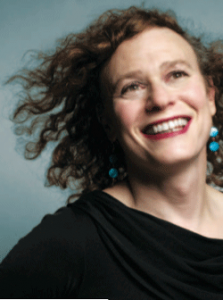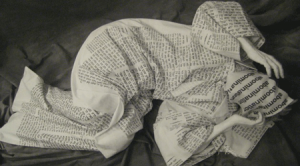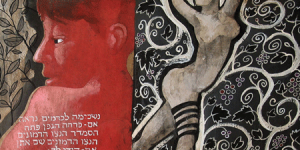Arts
Exhibit
The Arts: Spectrum Analysis

At first glance, the photograph of the joyous woman, frizzy hair flying away from her face to reveal turquoise earrings and a vibrant, lipsticked smile, seems surprisingly unassuming for the provocatively themed “Sexuality Spectrum,” an exhibition at the Hebrew Union College–Jewish Institute of Religion Museum in New York.
But look again, and a protruding Adam’s apple—a male characteristic—brings up a powerful new understanding. Jay/Joy Ladin is Joan Roth’s portrait of the first and only openly transgendered professor at an Orthodox institution—Stern College for Women. The photograph is part of a year-long exhibition https://huc.edu/museums/ny; through June 28, check Web site for information on additional venues and showing) featuring the works of 55 contemporary artists who explore evolving social and religious attitudes toward sexuality as well as issues of inclusion, alienation, marginalization, persecution, family, illness and aging.
The exhibition, says curator Laura Kruger, is not about gender, feminism, homosexuality “or sex sex,” but about the multilayered range of sexuality. Born of Kruger’s personal anger at the vehement rhetoric against the gay community, which reminded her of Nazi abhorrence of “the other,” Kruger determined to create a show intended to be a celebration of life. She received the university’s blessing to showcase art as a tool to mirror the yearning for a just and ethical world.

In fact, the shows range extends from the Judy Moonelis’s scientific Wonder—an installation of DNA particles and ladders that represents asexual and homosexual behavior in the natural world (1,500 species prefer one sex to another)—to the grandeur of heterosexual or divine-human love as depicted in David Wander’s acrylic-and-ink Come My Beloved and Song of Songs. The tefilin that in Wander winds around the thigh of a naked female body become an icon of vulnerability in Albert Winn’s Akedah. Winn photographed his own bare torso, the starkness broken only by tefilin bound around his arm, a band-aid visible through the straps. The fusion of the biblical binding of Isaac, the commandment for tefilin (“they will be a sign upon your hand), the disputed place of the gay community in Jewish life and the AIDS crisis offer a poignant contemporary meaning.
Words, both ancient and modern, are front and center in this exhibition. Joan Snyder exults in the freedom of breaking out of stereotypical language in My Maggie. Using bold stripes of color, Snyder crosses out labels for her life partner—mate, wife, girlfriend, significant other, spouse, companion, love, friend, Mrs.—and ends with the simplest, most appropriate and humanizing choice: her name. Helene Aylon turns a (literal) magnifying lens on Leviticus 20:3, which warns of death for the “abomination” of homosexuality.

Wrestling with Leviticus, a three-piece installation by Susan Kaplow, photographed by Trix Rosen, focuses on the pain engendered by the Talmudic commentary on the Leviticus text. Kaplow enlarged the Talmudic page, marked the Hebrew word “abomination” (to’eva) with earth from the Mount of Olives, printed the text on fabric, hand-sewed the cloth into shrouds and then clothed herself in it. “Because this abhorrence of my lesbian sexuality made me feel ‘dead,’ I used elements of the traditional Jewish burial ritual to create my artwork,” Kaplow writes on her Web site. Kaplow’s mixed media Wisdom of the Mothers rejects and riffs on the patriarchal maxims of Pirkei Avot by depicting mother’s milk as long strands of text flowing from the breasts of a female torso. Each strand holds a statement of wisdom from a key woman in Kaplow’s life. Andi Arnovitz addresses the profoundly painful problem of infertility in 4% of Us. Jewish law prohibits sexual contact for seven days after menstruation ceases, but 4 percent of women ovulate during that time, so are unable to conceive. Tiny clay fetuses represent unborn children.
The relationships between biblical pairs—most famously, David and Jonathan—have also been reexamined in this exhibition. In David’s Sorrow, Archie Rand frames a painting of two United States Air Force soldiers, circa WWII, with David’s lament upon Jonathan’s death (“Your love was wonderful to me, more than the love of women”). Dorit Jordan Dotan captures the same words on a pink sign abandoned on the ground during the Haifa Pride Parade; armed police standing near the sign appear to have been too late to defend the marchers’ rights (The Protectors). Dotan uses another biblical quote—“Whither thou goest I will go,” from the Book of Ruth—as the foreground for an intimate moment between two women. (Ruth and Naomi). Benton Spruance’s Jacob Wrestling with the Angel turns the patriarch’s struggle into an embrace, while Richard McBee depicts it as a haunting sexual assault. Portrayals of Adam and Eve, Lilith, and the prophet Deborah explore female sexuality, equality and power.
The often-overlooked victimization of homosexuals during the Holocaust finds expression in Judy Chicago’s Pansy Crucifixion, part of her “Holocaust Project.” Chicago inters three anguished naked figures in a pink triangle (the Nazi symbol for homosexuals). A wallpapered background of pansies alludes to Kaposi’s sarcoma lesions, which resemble pansies, and the derogatory term for homosexuals. Richard Grune’s rare wartime lithograph is a first-person testimonial to the brutality he experienced as one of the 100,000 gay men persecuted during the Holocaust; at least half perished in concentration camps. Linda Soberman personalizes the victims by adding photographs to the backs of miniature empty chairs that dangle, grouped, from the ceiling.
Not all is somber and serious. A series of cartoons by William Haefeli that appeared in The New Yorker add humor. In one, a student creating a “Mothers’ Day” card responds to a teacher’s correction: “I have two mommies. I know where the apostrophe goes.” Joan Roth’s photograph of a girl holding a sign that reads, “My Mom is Gay, and That’s Okay,” normalizes gay families, as does Larry Frankel’s self-portrait: on a shelf in his library, siddurim mingle with books that explore sexuality. These straightforward images are some of the most powerful in the exhibition, as they focus on the integration and validation of the gay community in Jewish and secular society as well as on its own self-acceptance.










 Facebook
Facebook Instagram
Instagram Twitter
Twitter
Leave a Reply